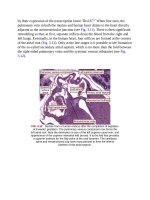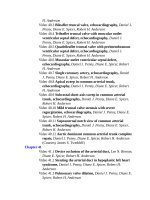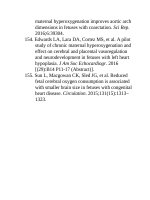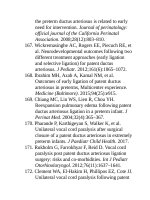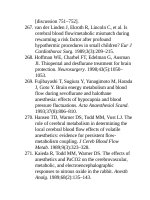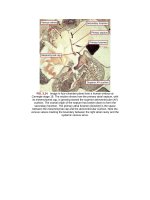Andersons pediatric cardiology 1841
Bạn đang xem bản rút gọn của tài liệu. Xem và tải ngay bản đầy đủ của tài liệu tại đây (88.13 KB, 3 trang )
oxygenconsumption(VO2)islessthanO2demandandtheneonaterelies
increasinglyonanaerobicmetabolismtomaintainenergysubstrate.Accordingly,
shockresultsfromeitherimpairedoxygenation,O2-carryingcapacity,or
delivery,allofwhichisoftencompoundedbyanelevatedO2demand.
OxygenationandO2content(CaO2)arecompromisedduetothemixingof
systemicandpulmonaryvenousreturn;thussystemicbloodflow(Qs)must
compensatetomaintainadequatetissueoxygenation.
ThehealthoftheneonatewithafUVHandshockwillbecompoundedbyan
elevatedO2demand.Theprimaryfactorsresponsibleforanincreasein
metabolismincludeincreasedventilatorydemandandimpairedrespiratory
mechanics,resultinginamarkedincreaseinrespiratorymuscleVO2and
correspondingDO2;elevatedmyocardialO2demand;andelevatedtotalbody
VO2duetocatecholamineexposure(endo-andexogenoussources).
AssessmentofSystemicOxygenDelivery(See
AlsoChapter70)
Standard“hemodynamic”parameterssuchasbloodpressure,heartrate,and
arterialoxygensaturations(SaO2),andtheperfusionexammaynotprovidean
accurateindicationoftheadequacyofDO2.TheSaO2maybeelevated,
indicatingagenerousQp,butthatdoesnotnecessarilyhavetooccuratthe
expenseofQsandDO2ifthetotalcardiacoutput(CO)isadequate.Conversely,
an“acceptable”SaO2(e.g.,80%)doesnotindicateadequateDO2ifthetotalCO
islimited.AnormalorelevatedbloodpressuredoesnotindicateadequateDO2
asSVRmaybecompensatingforalowQs.Thisisaparticularlyimportant
considerationinpatientswithafUVHandmultidistributionphysiology,asan
elevatedandrisingSVR/pulmonaryvascularresistance(PVR)ratiocreatesa
positivefeedbackcyclethatculminatesintissuehypoxiaandshock.AsQsfalls
andbecomeslimited,neurohormonalactivationensues,which—ifsystolic
functionisimpaired—causesstrokevolumeandCOtodecreasewhileincreasing
theSVR/PVRratio,thusincreasingtheQp/Qs.Andinthisinstancetheincrease
inQpisoccurringattheexpenseofthesystemiccirculation.
OnestrategythatmaybeusedtoassessQsandDO2istheuseofvenousand
orcerebralNIRSoximetry,whichreliesontheuseofamanipulatedand
simplifiedFickequation:
whereScvO2isthecentralvenousO2saturationobtainedfromthejugularvein,
superiorvenacava,orinferiorvenacava–rightatrialjunctureandSaO2−
ScvO2/SaO2istheoxygenextractionratio(O2ER).37aAcerebralNIRSO2
saturationmaybeusedasurrogateforregional(cerebral)andglobal(ScvO2)
VO2/DO2analysis;however,thereareimportantfactorstoconsider,whichare
discussedelsewhere.DO2iscoupledtometabolism,whichisaccomplishedby
visceramodulatingvasomotortone,bloodflow,andregionalDO2.TheO2ER
increasesfromnormal(25%to30%orso)whenDO2becomeslimited.AO2ER
of50%to60%isconsistentwithimpendingshockandthecriticalO2ER
(definedbytheonsetofanaerobicmetabolismandfallinVO2withouta
decrementinO2demand)is60%orso.38Clinicalfindingsconsistentwith
impendingorexistingshockincludeanelevatedO2ERthatisapproachingifnot
exceedingthe“critical”O2ERandlacticacidosis.Animportantlimitationof
lactatelevelsisthattheO2ERmustexceedcriticallevelsforlactateproduction
toexceeditsclearance.
Theprinciplesofinitialsimultaneousassessmentandmanagementare
outlinedinTable71.2.Thetoppriorityshouldbetoestablishaccessforthe
initiationofprostaglandin,correctionofacidosis,andinitiationofinotropic
support.Thedoseofprostaglandinneededtoopentheconstrictedductus
arteriosusis0.1to0.2µg/kgperminute,whichis10to20timeshigherthanthat
neededtomaintainpatencytypically0.01µg/kgperminute.Apneacanoccur
withtheinitiationofhigh-doseprostaglandin;thereforethepatientshouldbe
preparedforintubation.Thecaveattointubatingtheneonateinshockisthat
tachypneamaybearesponsetoaprofoundmetabolicacidosis;thereforeminute
ventilationshouldbehighuntilthemetaboliccomponenthasbeencorrected.
Partialcorrectionoftheacidosiswithsodiumbicarbonateshouldbeconsidered
priortointubation.Supplementaloxygenshouldbeadministeredwithcaution,
asoncethepatencyoftheductusarteriosushasbeenreestablished,oxygencan
decreasePVRandincreasemaldistributionofflowintothepulmonaryvascular
bed.Itisgenerallyrecommendednotto“intubatefortransport,”aspreoperative
intubationcarriesriskduringtheprocedure;italsoincreasesthemortalityrisk
forsubsequentsurgery,thelikelihoodofearlierextubation,andthehospital
lengthofstay.39–42
Table71.2
ABCApproachtoSimultaneousAssessmentandManagementofa
NeonateinShockWithaFunctionallyUniventricularHeart
Assessment
Management
Airway/Access/Antibiotics Placementofanairwayshouldoccur,occasionallyfollowingpartialcorrectionof
acidosiswithsodiumbicarbonate
Peripheral,umbilical,orcentralaccess
Antibioticsaretypicallystarted,particularlyifthebirthhasbeenpremature
Breathing
Tachypneaiscommonsecondarytopulmonaryedemafromleftatrialhypertension
(restrictiveatrialseptaldefect),increasedlungwater(fromincreasedpulmonary
bloodflow),andtocompensateformetabolicacidosis
Titrateoxygenforasaturationof80%–85%andmixedvenousoxygensaturation
>50%
Inmostcasessupplementaloxygenisnotnecessarywhenthepatencyofthearterial
ductisestablished(seeChapter70)
Circulation
Prostaglandininitiationathighdose0.1–0.2µ/kgperminute,withreductionto
lowesteffectivedoseonceductalpatencyisconfirmed,typically0.01µg/kgper
minute
Volumeadministration10mL/kgisotonicfluidbolusesasnecessary
Inotropicsupportforfailingventriclewithdopamineorepinephrine,consideration
formilrinonetoreducesystemicvascularresistance(althoughpulmonaryvascular
resistancemayfallaswell)
Inspiredgasestopotentiallyelevatepulmonaryvascularresistanceandimprove
systemicoxygendeliveryarecontroversialandusedvariablyatdifferentcenters.
Urgentbilateralpulmonaryarterybandingforstabilizationachievesthesamegoal
withmorepredictabilityandlittleeffectonthepreoperativevasculartoneofthe
pulmonaryendothelium.2,46,47
Oncetheneonatehasbeenstabilized,acomprehensiveevaluationforendorganfunctionshouldoccur.Thisincludesassessmentforintracranial
hemorrhageandischemicbraininjury,necrotizingenterocolitis,andtestingof
hepaticandrenalfunction.However,iftheneonateremainsunstablewithout
end-organrecovery,worseningend-organinjury,andongoingacidosis,bilateral
pulmonaryarterybandingcanbeperformedtoincreasesystemicbloodflowand
decreaseflowtothepulmonaryvascularbed,thusallowingforend-organ
recovery.Thisstrategyhasbeenshowntoimprovesystolicbloodpressure,renal
function,andacidosiswithrecoveryofendorganfunction,allowingformore
definitivesurgicalpalliationsincludingtheNorwoodoperationand
transplantation.43–45
